In order to celebrate the today cosmic alignment between the star Antares (The Scorpion), Earth, Sun and the star Aldebaran (The Bull) — the “central equator of the Zodiac” and one of the most significant Directions for the evolution of our Solar System and Planet — here are some extracts about the Zodiac symbolic Reality (from the precious work by Manly P. Hall, “The Secret Teachings of all Ages”, H. S. Crocker Company, 1928 – pictures, endnote and underlined parts are from the editor):
“The Chaldeans, Phœnicians, Egyptians, Persians, Hindus, and Chinese all had zodiacs that were much alike in general character, and different authorities have credited each of these nations with being the cradle of astrology and astronomy. The Central and North American Indians also had an understanding of the zodiac, but the patterns and numbers of the signs differed in many details from those of the Eastern Hemisphere.
[…] the Greek word zodiakos comes from zo-on, meaning “an animal.” He adds: “This latter word is compounded directly from the primitive Egyptian radicals, zo, life, and on, a being.”
[…] the zodiacal signs were derived from the star groups which they now represent. It is far more probable that the creatures assigned to the twelve houses are symbolic of the qualities and intensity of the sun’s power while it occupies different parts of the zodiacal belt. […] the collections of stars, named after certain animals, have no resemblance whatever to those animals; which are therefore merely signs of convention adopted to distinguish certain portions of the heavens, which were probably consecrated to those particular personified attributes, which they respectively represented. […]
Among the ancients the sun was always symbolized by the figure and nature of the constellation through which it passed at the vernal equinox. For nearly the past 2,000 years the sun has crossed the equator at the vernal equinox in the constellation of Pisces (the Two Fishes). For the 2,160 years before that it crossed through the constellation of Aries (the Ram). Prior to that the vernal equinox was in the sign of Taurus (the Bull). It is probable that the form of the bull and the bull’s proclivities were assigned to this constellation because the bull was used by the ancients to plow the fields, and the season set aside for plowing and furrowing corresponded to the time at which the sun reached the segment of the heavens named Taurus.
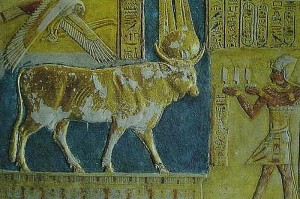 […] In ancient Egypt it was during this period–when the vernal equinox was in the sign of Taurus–that the Bull, Apis, was sacred to the Sun God, who was worshiped through the animal equivalent of the celestial sign which he had impregnated with his presence at the time of its crossing into the Northern Hemisphere. This is the meaning of an ancient saying that the celestial Bull “broke the egg of the year with his horns.”
[…] In ancient Egypt it was during this period–when the vernal equinox was in the sign of Taurus–that the Bull, Apis, was sacred to the Sun God, who was worshiped through the animal equivalent of the celestial sign which he had impregnated with his presence at the time of its crossing into the Northern Hemisphere. This is the meaning of an ancient saying that the celestial Bull “broke the egg of the year with his horns.”
Sampson Arnold Mackey, in his Mythological Astronomy of the Ancients Demonstrated, makes note of two very interesting points concerning the bull in Egyptian symbolism. Mr. Mackey is of the opinion that the motion of the earth that we know as the alternation of the poles has resulted in a great change of relative position of the equator and the zodiacal band. He believes that originally the band of the zodiac was at right angles to the equator, with the sign of Cancer opposite the north pole and the sign of Capricorn opposite the south pole. It is possible that the Orphic symbol of the serpent twisted around the egg attempts to show the motion of the sun in relation to the earth under such conditions. Mr. Mackey advances the Labyrinth of Crete, the name Abraxas, and the magic formula, abracadabra, among other things, to substantiate his theory. Concerning abracadabra he states:
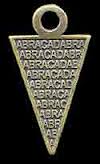 “But the slow progressive disappearance of the Bull is most happily commemorated in the vanishing series of letters so emphatically expressive of the great astronomical fact. For ABRACADABRA is The Bull, the only Bull. The ancient sentence split into its component parts stands thus: Ab’r-achad-ab’ra, i. e., Ab’r, the Bull; achad, the only, &c.– Achad is one of the names of the Sun, given him in consequence of his Shining ALONE,–he is the ONLY Star to be seen when he is seen–the remaining ab’ra, makes the whole to be, The Bull, the only Bull; while the repetition of the name omitting a letter, till all is gone, is the most simple, yet the most satisfactory method that could have been devised to preserve the memory of the fact; and the name of Sorapis, or Serapis, given to the Bull at the above ceremony puts it beyond all doubt.
“But the slow progressive disappearance of the Bull is most happily commemorated in the vanishing series of letters so emphatically expressive of the great astronomical fact. For ABRACADABRA is The Bull, the only Bull. The ancient sentence split into its component parts stands thus: Ab’r-achad-ab’ra, i. e., Ab’r, the Bull; achad, the only, &c.– Achad is one of the names of the Sun, given him in consequence of his Shining ALONE,–he is the ONLY Star to be seen when he is seen–the remaining ab’ra, makes the whole to be, The Bull, the only Bull; while the repetition of the name omitting a letter, till all is gone, is the most simple, yet the most satisfactory method that could have been devised to preserve the memory of the fact; and the name of Sorapis, or Serapis, given to the Bull at the above ceremony puts it beyond all doubt.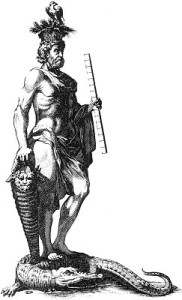 This word (Abracadabra) disappears in eleven decreasing stages; as in the figure. And what is very remarkable, a body with three heads is folded up by a Serpent with eleven Coils, and placed by Sorapis: and the eleven Volves of the Serpent form a triangle similar to that formed by the ELEVEN diminishing lines of the abracadabra.”
This word (Abracadabra) disappears in eleven decreasing stages; as in the figure. And what is very remarkable, a body with three heads is folded up by a Serpent with eleven Coils, and placed by Sorapis: and the eleven Volves of the Serpent form a triangle similar to that formed by the ELEVEN diminishing lines of the abracadabra.”
Nearly every religion of the world shows traces of astrological influence. The Old Testament of the Jews, its writings overshadowed by Egyptian culture, is a mass of astrological and astronomical allegories. Nearly all the mythology of Greece and Rome may be traced in star groups. Some writers are of the opinion that the original twenty-two letters of the Hebrew alphabet were derived from groups of stars, and that the starry handwriting on the wall of the heavens referred to words spelt out, with fixed stars for consonants, and the planets, or luminaries, for vowels. These, coming into ever-different combinations, spelt words which, when properly read, foretold future events.
As the zodiacal band marks the pathway of the sun through the constellations, it results in the phenomena of the seasons. The ancient systems of measuring the year were based upon the equinoxes and the solstices. The year always began with the vernal equinox, celebrated March 21 with rejoicing to mark the moment when the sun crossed the equator northward up the zodiacal arc. The summer solstice was celebrated when the sun reached its most northerly position, and the day appointed was June 21. After that time the sun began to descend toward the equator, which it recrossed southbound at the autumnal equinox, September 21. The sun reached its most southerly position at the winter solstice, December 21.
Four of the signs of the zodiac have been permanently dedicated to the equinoxes and the solstices; and, while the signs no longer correspond with the ancient constellations to which they were assigned, and from which they secured their names, they are accepted by modern astronomers as a basis of calculation. The vernal equinox is therefore said to occur in the constellation of Aries (the Ram). It is fitting that of all beasts a Ram should be placed at the head of the heavenly flock forming the zodiacal band. Centuries before the Christian Era, the pagans revered this constellation. Godfrey Higgins states: “This constellation was called the ‘Lamb of God.’ He was also called the ‘Savior,’ and was said to save mankind from their sins. He was always honored with the appellation of ‘Dominus’ or ‘Lord.’ He was called the ‘Lamb of God which taketh away the sins of the world.’ […] Therefore, the Lamb of God is a title given to the sun, who is said to be reborn every year in the Northern Hemisphere in the sign of the Ram, although, due to the existing discrepancy between the signs of the zodiac and the actual star groups, it actually rises in the sign of Pisces.
The summer solstice is regarded as occurring in Cancer (the Crab), which the Egyptians called the scarab–a beetle of the family Lamellicornes, the head of the insect kingdom, and sacred to the Egyptians as the symbol of Eternal Life. It is evident that the constellation of the Crab is represented by this peculiar creature because the sun, after passing through this house, proceeds to walk backwards, or descend the zodiacal arc. Cancer is the symbol of generation, for it is the house of the Moon, the great Mother of all things and the patroness of the life forces of Nature. Diana, the moon goddess of the Greeks, is called the Mother of the World. Concerning the worship of the feminine or maternal principle, Richard Payne Knight writes:
“By attracting or heaving the waters of the ocean, she naturally appeared to be the sovereign of humidity; and by seeming to operate so powerfully upon the constitutions of women, she equally appeared to be the patroness and regulatress of nutrition and passive generation: whence she is said to have received her nymphs, or subordinate personifications, from the ocean; and is often represented by the symbol of the sea crab, an animal that has the property of spontaneously detaching from its own body any limb that has been hurt or mutilated, and reproducing another in its place.” (The Symbolical Language of Ancient Art and Mythology.) This water sign, being symbolic of the maternal principle of Nature, and recognized by the pagans as the origin of all life, was a natural and consistent domicile of the moon.
The autumnal equinox apparently occurs in the constellation of Libra (the Balances). The scales tipped and the solar globe began its pilgrimage toward the house of winter. The constellation of the Scales was placed in the zodiac to symbolize the power of choice, by means of which man may weigh one problem against another. Millions of years ago, when the human race was in the making, man was like the angels, who knew neither good nor evil. He fell into the state of the knowledge of good and evil when the gods gave him the seed for the mental nature. From man’s mental reactions to his environments he distills the product of experience, which then aids him to regain his lost position plus an individualized intelligence. Paracelsus said: “The body comes from the elements, the soul from the stars, and the spirit from God. All that the intellect can conceive of comes from the stars (the spirits of the stars, rather than the material constellations).”
The constellation of Capricorn, in which the winter solstice theoretically takes place, was called The House of Death, for in winter all life in the Northern Hemisphere is at its lowest ebb. Capricorn is a composite creature, with the head and upper body of a goat and the tail of a fish. In this constellation the sun is least powerful in the Northern Hemisphere, and after passing through this constellation it immediately begins to increase. Hence the Greeks said that Jupiter (a name of the Sun God) was suckled by a goat. […]
The period of 2,160 years required for the regression of the sun through one of the zodiacal constellations is often termed an age. According to this system, the age secured its name from the sign through which the sun passes year after year as it crosses the equator at the vernal equinox. From this arrangement are derived the terms The Taurian Age, The Aryan Age, The Piscean Age, and The Aquarian Age. During these periods, or ages, religious worship takes the form of the appropriate celestial sign–that which the sun is said to assume as a personality in the same manner that a spirit assumes a body. These twelve signs are the jewels of his breastplate and his light shines forth from them, one after the other.
From a consideration of this system, it is readily understood why certain religious symbols were adopted during different ages of the earth’s history; for during the 2,160 years the sun was in the constellation of Taurus, it is said that the Solar Deity assumed the body of Apis, and the Bull became sacred to Osiris.[…] During the Aryan Age the Lamb was held sacred and the priests were called shepherds. Sheep and goats were sacrificed upon the altars, and a scapegoat was appointed to bear the sins of Israel.
During the Age of Pisces, the Fish was the symbol of divinity and the Sun God fed the multitude with two small fishes. The frontispiece of Inman’s Ancient Faiths shows the goddess Isis with a fish on her head; and the Indian Savior God, Christna, in one of his incarnations was cast from the mouth of a fish.
Not only is Jesus often referred to as the Fisher of Men, but as John P. Lundy writes: “The word Fish is an abbreviation of this whole title, Jesus Christ, Son of God, Savior, and Cross; or as St. Augustine expresses it, ‘If you join together the initial letters of the five Greek words, Ἰησοῦς Χριστος Θεου Υιὸσ Σωτήρ, which mean Jesus Christ, Son of God, Savior, they will make ΙΧΘΥΣ, Fish, in which word Christ is mystically understood, because He was able to live in the abyss of this mortality as in the depth of waters, that is, without sin.'” (Monumental Christianity.) Many Christians observe Friday, which is sacred to the Virgin (Venus), upon which day they shall eat fish and not meat. The sign of the fish was one of the earliest symbols of Christianity […].
Aquarius is called the Sign of the Water Bearer, or the man with a jug of water on his shoulder mentioned in the New Testament. This is sometimes shown as an angelic figure, supposedly androgynous, either pouring water from an urn or carrying the vessel upon its shoulder. Among Oriental peoples, a water vessel alone is often used. […] The water pouring from the urn of Aquarius under the name of “the waters of eternal life” appears many times in symbolism. So it is with all the signs. Thus the sun in its path controls whatever form of worship man offers to the Supreme Deity.
There are two distinct systems of astrological philosophy. One of them, the Ptolemaic, is geocentric: the earth is considered the center of the solar system, around which the sun, moon, and planets revolve. Astronomically, the geocentric system is incorrect; but for thousands of years it has proved its accuracy when applied to the material nature of earthly things. A careful consideration of the writings of the great occultists and a study of their diagrams reveal the fact that many of them were acquainted with another method of arranging the heavenly bodies.
The other system of astrological philosophy is called the heliocentric. This posits the sun in the center of the solar system, where it naturally belongs, with the planets and their moons revolving about it. The great difficulty, however, with the heliocentric system is that, being comparatively new, there has not been sufficient time to experiment successfully and catalogue the effects of its various aspects and relationships. Geocentric astrology, as its name implies, is confined to the earthy side of nature, while heliocentric astrology may be used to analyze the higher intellectual and spiritual faculties of man.
[…] The zodiac necessarily must be ancient enough to go backward to that period when its signs and symbols coincided exactly with the positions of the constellations whose various creatures in their natural functions exemplified the outstanding features of the sun’s activity during each of the twelve months. One author, after many years of deep study on the subject, believed man’s concept of the zodiac to be at least five million years old. In all probability it is one of the many things for which the modern world is indebted to the Atlantean or the Lemurian civilizations.[1] About ten thousand years before the Christian Era there was a period of many ages when knowledge of every kind was suppressed, tablets destroyed, monuments torn down, and every vestige of available material concerning previous civilizations completely obliterated. Only a few copper knives, some arrowheads, and crude carvings on the walls of caves bear mute witness of those civilizations which preceded this age of destruction. Here and there a few gigantic structures have remained which, like the strange monoliths on Easter Island, are evidence of lost arts and sciences and lost races.
The human race is exceedingly old. Modern science counts its age in tens of thousands of years; occultism, in tens of millions. There is an old saying that “Mother Earth has shaken many civilizations from her back,” and it is not beyond reason that the principles of astrology and astronomy were evolved millions of years before the first white man appeared.
The occultists of the ancient world had a most remarkable understanding of the principle of evolution. They recognized all life as being in various stages of becoming. They believed that grains of sand were in the process of becoming human in consciousness but not necessarily in form; that human creatures were in the process of becoming planets; that planets were in the process of becoming solar systems; and that solar systems were in the process of becoming cosmic chains; and so on ad infinitum. One of the stages between the solar system and the cosmic chain was called the zodiac; therefore they taught that at a certain time a solar system breaks up into a zodiac. The houses of the zodiac become the thrones for twelve Celestial Hierarchies, or as certain of the ancients state,  ten Divine Orders. Pythagoras taught that 10, or the unit of the decimal system, was the most perfect of all numbers, and he symbolized the number ten by the lesser tetractys, an arrangement of ten dots in the form of an upright triangle.
ten Divine Orders. Pythagoras taught that 10, or the unit of the decimal system, was the most perfect of all numbers, and he symbolized the number ten by the lesser tetractys, an arrangement of ten dots in the form of an upright triangle.
The early star gazers, after dividing the zodiac into its houses, appointed the three brightest stars in each constellation to be the joint rulers of that house. Then they divided the house into three sections of ten degrees each, which they called decans. These, in turn, were divided in half, resulting in the breaking up of the zodiac into seventy-two duodecans of five degrees each. Over each of these duodecans the Hebrews placed a celestial intelligence, or angel, and from this system, has resulted the Qabbalistic arrangement of the seventy-two sacred names, which correspond to the seventy-two flowers, knops, and almonds upon the seven-branched Candlestick of the Tabernacle, and the seventy-two men who were chosen from the Twelve Tribes to represent Israel.
[…] “The division here [is] in twelve parts, the twelve signs of the Zodiac, twelve tribes of Israel, twelve gates of heaven mentioned in Revelation, and twelve entrances or portals to be passed through in the Great Pyramid, before finally reaching the highest degree, and twelve Apostles in the Christian doctrines, and the twelve original and perfect points in Masonry.”
The ancients believed that the theory of man’s being made in the image of God was to be understood literally. They maintained that the universe was a great organism not unlike the human body, and that every phase and function of the Universal Body had a correspondence in man. The most precious Key to Wisdom that the priests communicated to the new initiates was what they termed the law of analogy. Therefore, to the ancients, the study of the stars was a sacred science, for they saw in the movements of the celestial bodies the ever-present activity of the Infinite Father.
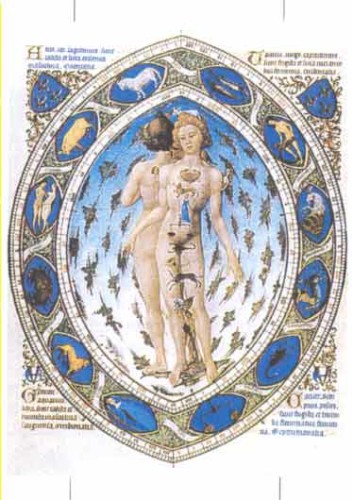 The Pythagoreans were often undeservedly criticized for promulgating the so-called doctrine of metempsychosis, or the transmigration of souls. This concept as circulated among the uninitiated was merely a blind, however, to conceal a sacred truth. Greek mystics believed that the spiritual nature of man descended into material existence from the Milky Way–the seed ground of souls–through one of the twelve gates of the great zodiacal band. The spiritual nature was therefore said to incarnate in the form of the symbolic creature created by Magian star gazers to represent the various zodiacal constellations. If the spirit incarnated through the sign of Aries, it was said to be born in the body of a ram; if in Taurus, in the body of the celestial bull. All human beings were thus symbolized by twelve mysterious creatures through the natures of which they were able to incarnate into the material world. The theory of transmigration was not applicable to the visible material body of man, but rather to the invisible immaterial spirit wandering along the pathway of the stars and sequentially assuming in the course of evolution the forms of the sacred zodiacal animals.
The Pythagoreans were often undeservedly criticized for promulgating the so-called doctrine of metempsychosis, or the transmigration of souls. This concept as circulated among the uninitiated was merely a blind, however, to conceal a sacred truth. Greek mystics believed that the spiritual nature of man descended into material existence from the Milky Way–the seed ground of souls–through one of the twelve gates of the great zodiacal band. The spiritual nature was therefore said to incarnate in the form of the symbolic creature created by Magian star gazers to represent the various zodiacal constellations. If the spirit incarnated through the sign of Aries, it was said to be born in the body of a ram; if in Taurus, in the body of the celestial bull. All human beings were thus symbolized by twelve mysterious creatures through the natures of which they were able to incarnate into the material world. The theory of transmigration was not applicable to the visible material body of man, but rather to the invisible immaterial spirit wandering along the pathway of the stars and sequentially assuming in the course of evolution the forms of the sacred zodiacal animals.
In the Third Book of the Mathesis of Julius Firmicus Maternus appears the following extract concerning the positions of the heavenly bodies at the time of the establishment of the inferior universe: “According to Æsculapius, therefore, and Anubius, to whom especially the divinity Mercury committed the secrets of the astrological science, the geniture of the world is as follows: They constituted the Sun in the 15th part of Leo, the Moon in the 15th part of Cancer, Saturn in the 15th part of Capricorn, Jupiter in the 15th part of Sagittary, Mars in the 15th part of Scorpio, Venus in the 15th part of Libra, Mercury in the 15th part of Virgo, and the Horoscope in the 15th part of Cancer. Conformably to this geniture, therefore, to these conditions of the stars, and the testimonies which they adduce in confirmation of this geniture, they are of opinion that the destinies of men, also, are disposed in accordance with the above arrangement, as maybe learnt from that book of Æsculapius which is called Μυριογενεσις, (i.e. Ten Thousand, or an innumerable multitude of Genitures) in order that nothing in the several genitures of men may be found to be discordant with the above-mentioned geniture of the world.” The seven ages of man are under the control of the planets in the following order:
infancy, the moon; childhood, Mercury; adolescence, Venus; maturity, the sun; middle age, Mars; advanced age, Jupiter; and decrepitude and dissolution, Saturn.”





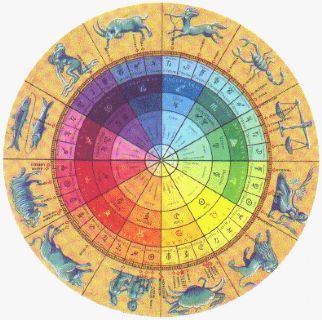
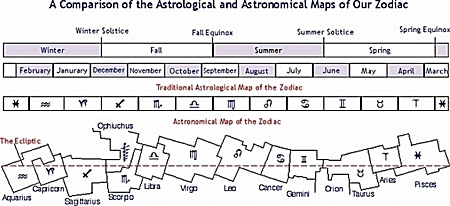
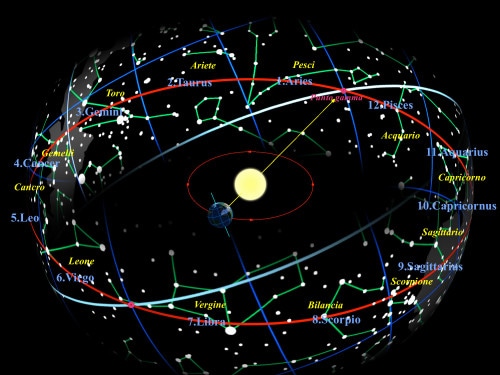

Excellent, most interesting, enjoyable, addresses questions that so many have concerning astrology and the cosmos. Thank you